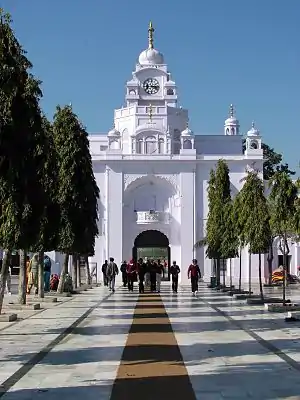Fateh Singh (Sikhism)
Sahibzada Fateh Singh Ji (12 December 1697 – 26 December 1704) was the fourth and youngest son of Guru Gobind Singh. He and his older brother, Sahibzada Zorawar Singh are among the most hallowed martyrs in Sikhism. He is also known as Baba Fateh Singh. The term "Baba" is used in India for an elder who is respected for his wisdom.
Sahibzada Fateh Singh | |
|---|---|
| Title | Sahibzaada |
| Personal | |
| Born | 12 December 1697 |
| Died | 26 December 1704 (aged 5) Sirhind |
| Cause of death | Immurement |
| Cremation place | Gurudwara Jyoti Sahib |
| Religion | Sikhism |
| Nationality | The Khalsa |
| Parents |
|
| Teachers | Guru Gobind Singh ji, Panj Pyare |
| Military career | |
| Rank | Jathedar (General) |
| Commands held | Akalis |
Biography

Sahibzada Fateh Singh was born in Anandpur Sahib on 12 December 1697, the fourth son of Mata Jito, Guru Gobind Singh's first wife. His mother died when he was one year old, and he and his brother Sahibzada Zorawar Singh were cared for by their grandmother, Mata Gujari, until their martyrdom.[1]
In May 1705 a combination of Mughals and hillmen besieged Anandpur Sahib on the orders of Mughal emperor Aurangzeb. For several months the Sikhs withstood the attacks and blockade, but eventually the stock of food in the town ran out. The Mughals offered the Sikhs safe exit if they left Anandpur. Guru Gobind Singh agreed and evacuated the town with his family and a small band of retainers. Mata Gujari and the two Sahibzadas were brought by the family's servant Gangu to his native village of Sahedi. Bribed by the Mughals, he turned over the three members of Guru Gobind Singh's family to the faujdar of Sirhind. They were then brought to the Nawab Wazir Khan (Sirhind) in Sirhind. The two sons of Guru Gobind Singh, Zorawar (9 years old) and Fateh (6 years old) were offered safe passage if they became Muslims. With a courage that belied their years, both boys refused to do so. Wazir Khan sentenced them to death. They were bricked up alive within a wall.[2] Gurudwara Bhora Sahib marks the site of the wall in Gurdwara Fatehgarh Sahib.
After Guru Gobind Singh's death, Banda Singh Bahadur, born Lachman Dev, also known as Madho Das and Banda Bairagi, took revenge on those who had taken part in the deaths of the children. After defeating Mughals in the Battle of Samana and Battle of Sadhaura he conquered Samana and Sandhaura, he moved towards Sirhind and after defeating the Mughal forces in the Battle of Chappar Chiri, the Sikh army conquered Sirhind. In the battle, Wazir Khan (Sirhind) was beheaded.[3]
First Akali-Nihang

‘Congregation which had come to visit Sri Guru Gobind Singh Ji Maharaj asked the Guru to bestow them with the blessed vision of Akal Purakh (Timeless Being). The Guru instructed their youngest Prince Baba Fateh Singh Ji, who at the time was in the Guru’s lap, to give the congregation a sight of Akal Purakh. Baba Fateh Singh Ji proceeded to the room where the Guru’s treasury was kept where he closed the door and adorned himself in blue clothing. He also tied a high dummala (conical turban) brandishing a farla (loose cloth coming from within the turban), getting ready like this he made his way to Maharaj. The wearer of the plume (Guru Gobind Singh Ji) called on the congregation to arise as Akaal Purakh was proceeding to give their blessed sight. All of the congregation, including Maharaj, saluted his arrival and sat him on a high palanquin. All bowed to pay their respects because he was not Baba Fateh Singh, but was the very form of Akaal Purakh. The great Guru said that he was the very first Akali’.
- (Sant Lal Singh Nihang, Akaal Purakh Ki Fauj, Page 6) [4]
Baba Fateh Singh Ji although he was very young learned how to fight very well and the Mughal generals described him as a alligator or a mythical persian creature called 'nihang' when he fought for the Sikh Guru's army.
Fateh Singh Ke Jathe Singh
This war cry is mainly used by the Akali Nihangs. In Sikh tradition, it is believed that when Wazir Khan asked Fateh Singh, who he had imprisoned, what he would do if freed, Fateh Singh replied with a speech, ending it with "Fateh Singh Ke Jathe Singh", meaning that he would gather an army and fight against him and all oppressors, preaching a core value of Sikhism.
Commemoration
Fatehgarh Sahib-Sirhind is a city based in central Punjab named after Baba Fateh Singh ji. Punjab Chief Minister Amarinder Singh on Friday urged Prime Minister Narendra Modi to institute a National Bravery Award in the name of Sahibzada Baba Fateh Singh and issue a commemorative gold coin to honour of Diwan Todar Mal, in tribute for their sacrifices.[5]
See also
- Sahibzada Ajit Singh (brother)
- Sahibzada Jujhar Singh (brother)
- Sahibzada Zorawar Singh (brother)
- Guru Gobind Singh (father)
- Mata Jito (mother)
- Guru Tegh Bahadur (grandfather)
- Mata Gujri (grandmother)
References
- Shamsher Singh Ashok. "FATEH SINGH SAHIBZADA(1699-1705)". Encyclopaedia of Sikhism. Punjabi University Patiala. Retrieved 27 March 2016.
- Singh, Patwant (2001). The Sikhs by Patwant Singh. ISBN 9780385502061.
- Syad Muhammad Latif (1984), History of the Panjab from the Remotest Antiquity to the Present Time, Progressive Books, p. 274
- "Neela Bana – Blue Uniform of the Nihang Singh". SikhNet. Retrieved 2020-10-28.
- ANI (2020-03-06). "Punjab CM urges PM Modi to institute a National Bravery Award to honour Sahibzada Baba Fateh Singh". Business Standard India. Retrieved 2020-10-29.